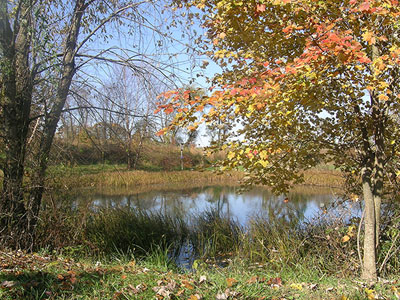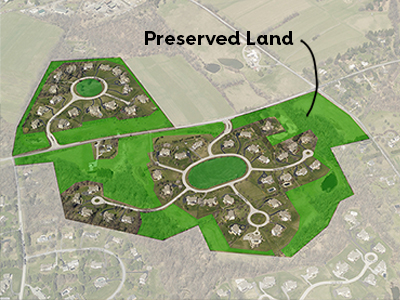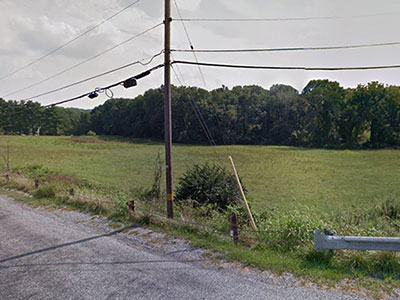Performance zoning is most frequently used in residential areas to take into account natural and historic features.
How it Works
Performance zoning, sometimes called "impact zoning" or "flexible zoning," is a method of regulating the design and location of a development based on factors that relate directly to the development's site and the specific effects of the development on its neighborhood. Performance zoning is a way to make traditional zoning more sensitive to the particular nature of specific development sites and has been used in both residential and non-residential developments.
Performance zoning regulations commonly require the identification and mapping of natural and manmade features that are to be protected on a property, while also taking into account the impacts that the development will have on the local neighborhood.
In performance zoning, natural features such as wetlands, watercourses, floodplains, and steep slopes are commonly protected from development, as well as woodlands, prime agricultural soils, and historic features. After these areas are identified and mapped, they are deducted from a site's development potential, and the remaining areas can then be developed at a density permitted by the zoning ordinance.
In addition to identifying site features that should be protected, performance zoning can also examine the impact of the development on the neighborhood and community, such as lost viewsheds, development that is incompatible with community character, and increased traffic. To ameliorate these impacts, performance zoning might require less intense development, changes to a development design, or improvements to adjoining roads.
Benefits
Balances Development with a Site's Carrying Capacity
The design matches the area's ability to accept development without overburdening the environment, utility and circulation system, etc.
Permits a Wider Range of Land Uses
When a site's capacity to accept development is balanced with the area's ability to accommodate increased demands on the environment, utility and circulation system, etc., more flexibility in site design and land uses could be permitted.
Reduces Potential Land Use Conflicts
Almost any land use can be made compatible with adjacent land uses if its potential adverse effects are eliminated or minimized.
Offers More Development Flexibility
The private sector can respond to market forces more quickly and can use more discretion in deciding on land use types.
Increases the Efficiency of Land Usage
Performance zoning can make better use of existing infrastructure, which will tend to encourage development (and redevelopment) into places Urban, Suburban and Suburban Center Landscape areas.

In this scenario, performance zoning is used to allow an old industrial building to have new uses while natural areas are restored and existing homes are buffered.
The Newlin Greene development matches the number of new homes with the carrying capacity of the land.
Get Started
A municipality should first establish land use policies in its comprehensive plan that support the concepts that will be implemented through performance zoning regulations. Performance zoning regulations are then implemented in a municipality's zoning ordinance and supplemented by a subdivision and land development ordinance.
A municipality must determine the criteria to be used for performance zoning, such as which physical and manmade features and considerations will be regulated. For instance, wetlands, floodplains and steep slopes are typically protected from development. Woodlands, prime agricultural soils and moderate slopes may also be deemed worthy of preservation. After preservation areas are mapped and then deducted from a site's development potential, the remaining areas may be developed at a density permitted by the zoning ordinance.
Regulations should also be included for maximum impervious surfaces and minimum open space areas. Depending on the type of performance controls used, the municipality may permit any form of residential development to be built. Non-residential development should be controlled through criteria such as floor-to-area ratio, maximum impervious surface ratios, accessibility to transportation, and availability of public water and sewer facilities.
The new homes at Newlin Greene are screened from the road.
The Newlin Greene development preserved the stream corridors, riparian woodlands, and viewshed from Marlboro Spring Road.
Considerations
Extent of Performance Zoning Areas
The municipality must decide how extensively it wants to use performance zoning. A municipality could permit any type of land use without regard to traditional zoning districts, while regulating the intensity of the land use through performance zoning controls. Alternatively, the municipality could use performance techniques only for residential land uses as a way of promoting open space and environmental protection.
Locational Requirements for Development
With performance zoning, there may be a district that allows a wide range of uses, with more intense development directed away from inappropriate areas through the use of stringent performance criteria and more intense development encouraged in more appropriate areas. For example, perhaps apartments are only allowed close to higher volume roads, with access to public sewer and water lines, and within a short distance of retail and other services.
Acceptance of Performance Approach
With a performance zoning approach, there can be less certainty over time where more intense development might occur, since this development is allowed wherever it meets the performance standards. Local homeowners and officials may not be comfortable with this potential uncertainty.
Enforcement of Regulations
Development using performance zoning can require more technical expertise and more involved review processes than conventional zoning.

Examples
Newlin Township
Newlin Township has used performance based zoning since 1990. Other Chester County municipalities use some performance-based techniques to regulate development and determine the required amounts of open space in new developments.

Bucks County
Performance zoning in southeastern Pennsylvania is generally recognized as having been first widely used in Bucks County. The Bucks County Planning Commission developed their performance zoning regulations in 1973, which was used almost exclusively for residential development.






